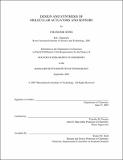Design and synthesis of molecular actuators and sensors
Author(s)
Song, Changsik
DownloadFull printable version (37.31Mb)
Other Contributors
Massachusetts Institute of Technology. Dept. of Chemistry.
Advisor
Timothy M. Swager.
Terms of use
Metadata
Show full item recordAbstract
To date, the most successful conducting polymer actuators are based on polypyrrole, which operates through incorporating and expelling counterions and solvent molecules to balance the charges generated by electrochemical stimuli (swelling mechanism). Although significant progress has been made, there still exists a need for developing new materials that would overcome the intrinsic limitations in the swelling mechanism, such as slow diffusion rate, limited expansion volume, etc. Our group has contributed this area with a different approach -- lecular mechanisms, which utilize a dimensional change of a single polymer chain. We propose two types of molecular mechanisms: contracting and expanding. We proposed earlier a calix[4]arenebased molecular actuator for the contracting mechanism, in which p-dimer formation was proposed as a driving force. In this dissertation, we first confirm by model studies that p-dimer formation can indeed be a driving force for the calix[4]arene-based system. We propose another molecular hinge, binaphthol moiety, for the contracting model. The syntheses of polymers with binaphthols and their characterization, including signatures of oligothiophene interactions, are described. Due to its chirality, we examined the possibilities of the binaphthol polymer as a chiral amine sensor. To create actuators that make use of the expanding model, we propose new conjugated seven-membered ring systems with heteroatoms (thiepin with sulfur and azepine with nitrogen) and their syntheses and characterization will be described. Inspired by the fact that sulfoxide has very low extrusion barrier in the related system, we applied the thiepin molecules to create a peroxide sensor. (cont.) In addition, during the investigation of phenol functional groups in conducting polymers, we found interesting properties that strategic positioning of phenol groups can render a conjugation-broken meta-linked system just as conductive as a fully conjugated para-linked isomeric system.
Description
Thesis (Ph. D.)--Massachusetts Institute of Technology, Dept. of Chemistry, 2007. This electronic version was submitted by the student author. The certified thesis is available in the Institute Archives and Special Collections. Includes bibliographical references.
Date issued
2007Department
Massachusetts Institute of Technology. Department of ChemistryPublisher
Massachusetts Institute of Technology
Keywords
Chemistry.